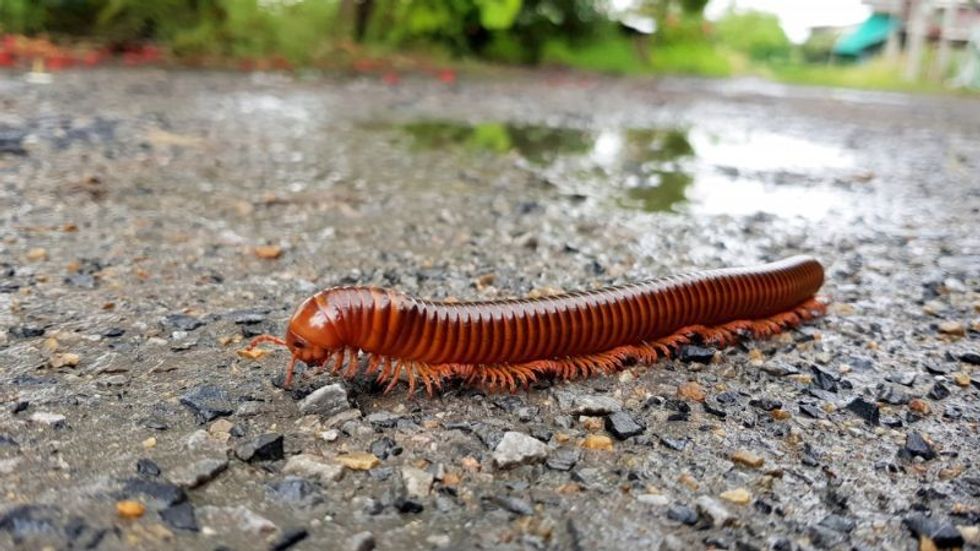Nobody wants millipedes or centipedes in their house, but can you tell them apart?
Millipedes and centipedes are often confused due to their similar appearances. Let us help you in spotting the differences easily!
Millipedes are arthropods that eat leaf litter and are either detritivores or herbivores. On the other hand, centipedes are predators that feed on insects and spiders.
Factually speaking, there is only one thing that is similar between centipedes and millipedes- and it is the fact that both of these invertebrates have many legs.
However, when we look into the facts and figures about millipedes, we realize that they have a completely different set of features and characteristics such as a defensive and docile nature and numerous pairs of legs that remain hidden. Keep reading for many such millipede facts that will blow you away!
If you enjoy reading this article, why not also check out what do millipedes eat and centipede vs millipede here at Kidadl!
Number Of Legs A Millipede Has
When we break down the name 'millipede', we find out that this worm-like creature has in fact been named after the Greek word 'milli', which means thousand. Unlike what most people believe to be true, millipedes do not actually have a thousand legs.
In fact, the leggiest millipede that has been discovered as yet only has around 750 legs. Most millipede species only have around 100 legs, although the number is specific to species and its growth patterns.
Most species of these invertebrates have legs in the range of around 40-400 legs, although the numbers are largely variable. Millipedes belong to the phylum of arthropods which are basically worms or insects that have a hard exoskeleton.
In order to grow or make more legs, millipedes go through a process of molting.
In this process, the exoskeleton is shed in order to grow a new one.
If the millipede in your backyard is one of the species that grow legs throughout its lifetime, it is likely that every time it molts it will also have a few new pairs of legs. Hence, scientists are yet to be able to put a finger on the exact number of legs that each millipede species would have.
Difference Between A Millipede And Centipede
Centipedes and millipedes are often confused since they are both leggy creatures, but there are many fundamental differences between them.
Both a centipede and a millipede would be classified as an arthropod, but there are differences in terms of body structure and behavior. In spite of the fact that both centipedes and millipedes are leggy creatures, there are some leg-related factors that are different in both.
A centipedes' legs often branch outside of its body and can easily be seen by any human being without much effort.
On the other hand, a millipedes' legs are almost hidden under its body and are not as prominent. This is also because a millipede's legs are shorter in comparison to those of a centipede.
These pests also differ on the basis of their behavior. While centipedes are often aggressive predators, millipedes are quite docile and defensive. Centipedes, being predators, have one pair of venomous claws towards the front end of the body. When required, many species of centipedes use their claws and venom for self-defense.
On the other hand, millipedes have no such defensive claws on their bodies. In fact, they are shy creatures and curl up when human beings or any predators are around.
However, when threatened by humans or animals, this arthropod can also secrete small amounts of toxins, which can cause irritation. Hence, it is advised that human beings handle millipedes with caution. These pests release small amounts of hydrogen cyanide, which is not fatal but can be harmful nonetheless.
A centipede can also be differentiated from its cousin millipede on the basis of how many legs emerge from each body segment. In centipedes, all body segments have a single pair of legs emerging from them.
In the case of millipedes, however, the bodies are designed differently. There are two pairs of jointed legs protruding from each of the body segments. This means that with two pairs in each segment, a few species of millipedes have more legs than centipedes!
Millipedes thus have countless feet, and each of these limbs is known as a double foot. This is because these arthropods have double the number of legs protruding from each segment of their body.
Why do millipedes have so many legs?
Now that we know how many legs millipedes have, the next question that may arise is why these creatures have so many legs.
Well, the answer is simple. In their natural habitat, both centipedes and millipedes require the capacity to dig through the earth in order to reach their food or burrow.
With most legs supporting and giving strength to the front pairs of legs, these worms and other arthropods are able to create a larger force. Even though millipedes do not have to use this force to kill insects and prey on them, they still need it to sift through the leaf litter that they eat!

Different Types Of Millipedes
There are many different species of arthropods, and hundreds of species of centipedes and millipedes are known to us to date.
One of the most common species of millipedes would include the giant African millipede. As the name suggests, these millipedes are huge and have a rather scary appearance. However, even these giant millipedes curl up when faced with any small danger!
Millipedes also occur in bright colors with a varying number of legs. One such millipede is the shocking pink dragon millipede. This variety of millipedes is rather curious-looking and can secrete a toxin that smells like almonds!
Helping Millipedes
Spotting centipedes and millipedes in the house may send you straight to panic mode, but many of these pests are perfectly harmless. In fact, if there are spiders or other insects in the house, a centipede may actually help you in easing the issue.
If you still want to get rid of the odd centipede or millipede in your house, the best thing to do would be to hire pest control. This will ensure that your house is pest-free, and at the same time, the centipede or millipede will be helped appropriately.
It must also be kept in mind that millipedes may not be dangerously harmful but we must be cautious nonetheless. This is because not all species of millipedes have been tested for poisonous traits.
Furthermore, some people also have undiagnosed allergies. Keep your house free of insects and litter, and if centipedes or millipedes still find their way in, consider getting professional help instead of risking yourself and your family!
Here at Kidadl, we have carefully created lots of interesting family-friendly facts for everyone to enjoy! If you liked our suggestions for millipede legs then why not take a look at are millipedes dangerous, or millipede facts?










